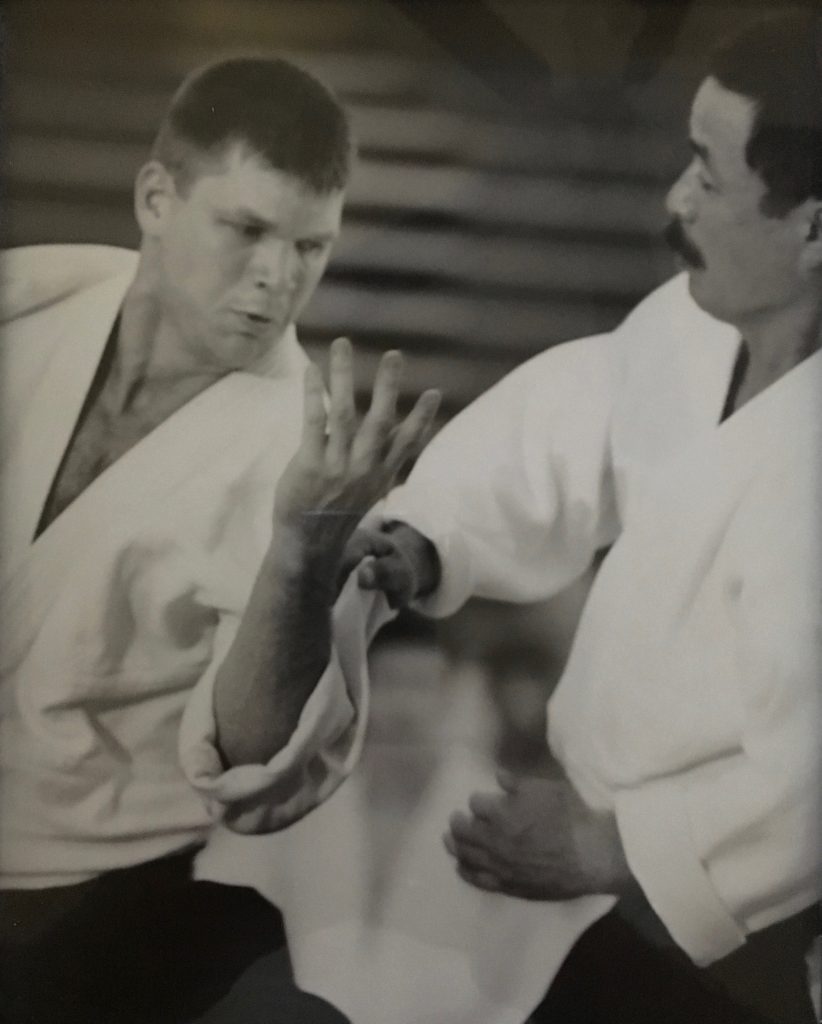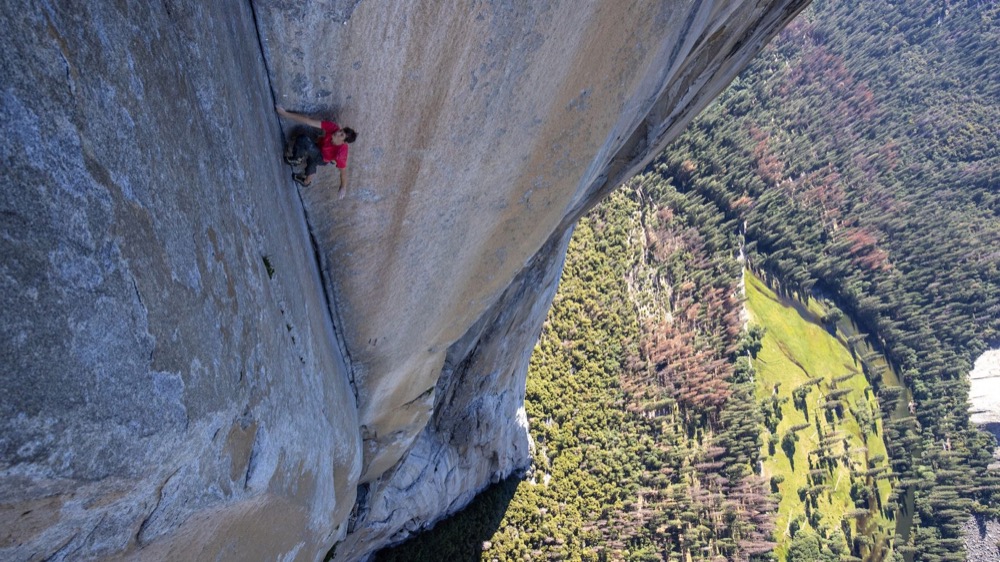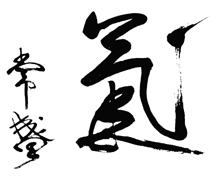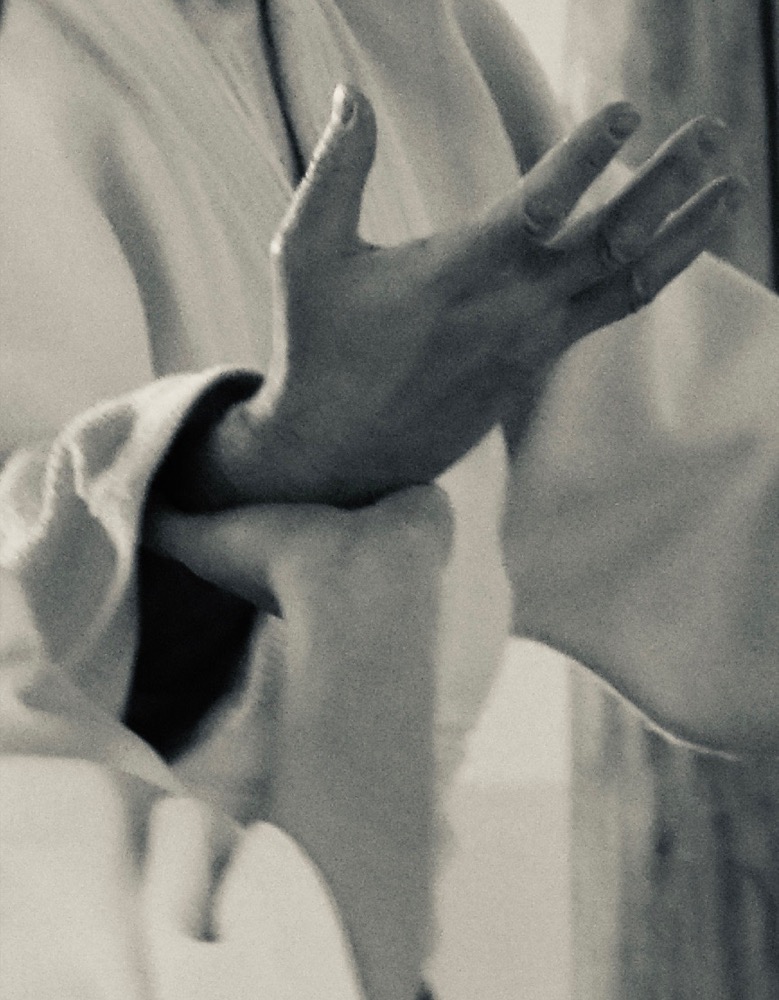Robert Angotti, Chief Instructor, North Wind Aikikai
I started aikido around the age of 21. I had found my way from Missouri to California and decided to try and establish residency in order to enroll in the California University system. SFSU had a good film school and a strong cultural anthropology program. I had my mind on doing something in ethnographic filmmaking.
The US government was engaged in the Gulf War at the time. I had a hard time reconciling the relationship between our national “oil interests” and the need to use war to preserve those interests. I was working, but I was also paying attention to the civil unrest around the war. At the same time, I was restless. I was looking for a practice to anchor me.
I had ended up in Berkeley by accident. A new friend had invited me to rest on his floor for awhile and that was really the only reason I spread some roots in the east bay rather than in the San Francisco peninsula. I also found the coffee at Pete’s in Berkeley to be be eye opening.
Protest
The war unrest was spilling over into a long held dispute over a piece of property just off the campus of UC Berkeley. Although the University owned the property, the piece of land that had come to be known as “people’s park” had been something of an homage to the “free speech” movement of the sixties. It wasn’t much to speak of however. There were a few blocks of ground that constituted the park. It was rundown and more uninviting than inviting. Nevertheless, the frustration over the war and the frustration with the University aiming to tear up the park for a parking lot (or something like that) had manifested in a protest held in the park one evening.
Around that same time, I was looking into martial arts. I had done some Tai Chi, but I longed from something more dynamic. My boss told me about aikido at one point, and described the dojo that he had practiced at. Back then, we had no google, no youtube, and no internet. I went to a library and borrowed some books on aikido and I went to observe a class.
The night of the protest at the park was both disappointing and formative. I stood by watching a mass of irritated protestors and anxious police wallow in a muddle of humanity without much leadership or purpose. In situations like this, the loudest voice or action sets the tone. The police were lined up on the perimeter of the crowd wearing riot armor and holding batons and rubber bullet rifles. That presented a very loud voice which was met by the unrepresentative but nevertheless loud voice of a couple people throwing glass bottles at the line of cops. Suddenly, the wall of police was pushing at the mass of people, moving them from the park with force. Within minutes a large majority of the crowd had scattered.
I soon found myself a block away from the park on a city street. At that point, I figured the police had done their job of moving us from the park and I figured had done mine in leaving. However, a group of 8 or more police advanced toward the street corner I was on. I decided to stand my ground.
An officer took the back end of his baton to my face in order to encourage me down the street. Turned by the blow, and gathering my feet, I was struck again as the officer jabbed the front end of the baton into my back. I made it farther down the street, and away form the police only to see other protestors being struck by rubber bullets. It was chaos and I started aikido the next day.
Entering Violence to find Harmony

It seems many people start martial arts looking to get some assurance about their ability to fight or protect themselves. Much of this is romanticized “hollywood hero” thinking, but much of it is anchored in an understanding that humans have been fighting each other for centuries. An attraction to martial arts is often motivated, at least in part, by a fear of conflict and a desire to somehow overcome that.
There were many reasons I started aikido nearly 30 years ago. I’m sure one of those reasons would have been fear. Fear hasn’t left me, although it has become mostly a background part of practice for me. It hovers there as an available energy source. I don’t enjoy tapping into that energy though because It is often so scattered and prone to misinterpretation of the moment.
In some way, seeing police suited up like soldiers and being attacked by a couple of them was formative. Violence is a tool, but on that street corner I witnessed how easily and brutishly it was employed. I witnessed how the the tool of violence is in the hand of those with more power and wealth. It’s hard to not want to use force when you’re dressed for it. Helmets, armor batons, and guns can become your voice, and your means of communication when you wear them.
I was attracted to Berkeley Aikikai because violence was a real presence and it allowed fear into the practice in order to see it and deal with it. My teacher, Shibata Sensei brought the potential for violence into the practice every day. As an apprentice (kenshusei) just showing up, involved accepting that engagement with violence was a reality. As I experienced it, the potential for violence provided an opportunity to pursue harmony in response to an energy that could be destructive. Harmonizing with the movement of my teacher was the path for neutralizing the potential violence within the practice. With Shibata Sensei’s guidance, I made that my fundamental practice for the next decade.
“To injure an opponent is to injure yourself. To control aggression without inflicting injury is aikido.”
― Morihei Ueshiba, Founder of Aikido
Social Cohesion
There are probably many ways I could have entered into telling my aikido origin story. I have rarely shared my story of the police incident with students. My story illustrates a tension in our society that seems to be as old as the nation itself and it may draw an uncomfortable level of attention to our divisions. Fundamentally, I am referring to the tension between those who wield power and those that they are supposed to serve.
Recently, I was listening to a military specialist describing the plot lines for social cohesion. He said there are two essential components for maintaining peace and social cohesiveness. First is a shared identity and second is the implementation of law and order. The stronger one of these is, the less important the other is.
When I think of a country like Japan, I can see just how powerful the shared identity of the Japanese people has been. Japan is an island, and has proudly maintained a unique ethnic identity for thousands of years. It is an identity deeply rooted in the traditions of its indigenous people. These traditions flow through aikido.
Comparatively, the indigenous people of our nation were nearly eradicated intentionally during colonization. Another race of people were either massacred or subordinated and enslaved for hundreds of years in order to build this country. The lives of black slaves were simply logs placed on the fire of “progress” as the fortunes of a white nation thrived. More lives were lost in a civil war aimed at trying to settle that injustice of identity than in any other American war and yet, it remains unresolved.
With a national identity that is so unsettled, the other tools for social cohesion have been pushed to their breaking point. Power has been a resource almost exclusively available to the wealthy since the dawn of our nation and all aspects of the law and order system have been at the service of the powerful. With an identity crises this significant, justice can become a commodity available to those that can afford it.
Now more than anytime in my life we lack social cohesion. Our president has made an art of watering the seeds of our division. A pandemic is exploiting the separation the “haves” and “have nots” for its spread and we fail to agree on the importance of saving lives and insuring equal justice.
A Path of Wisdom
In a journal the night I faced off against the police I wrote,
“Once the rod struck so true to my spine, I knew I stood alone.”
At that moment I was clearly a naive and idealistic kid, barely twenty and privileged by a white, middle class, male birth. I was living in my car and out of money, but I was far from impoverished. Birth had given me an identity advantage in this society. If I had been born black, I think what happened on that street corner would have been different.
That night there was no leadership in the crowd and no observable strategy or collective voice. My juvenile moment of civil disobedience would inevitably leave me feeling alone when the strong arm of law and order met my isolated spine. Aikido was a vehicle for channeling my anger and despair, and it held the promise of human reconciliation.
“Aiki is not a technique to fight with or defeat an enemy. It is the way to reconcile the world and make human beings one family. Just practice”.
― Morihei Ueshiba, Founder of Aikido
What is becoming clear to me now is that I still have so much to learn about the path of controlling aggression and “fostering peace” in my life as O’sensei has directed. Nevertheless, the times are what they are and I realize that sharing this story is tied to my sense of social responsibility. Civil disobedience is the tool for a population that is searching for a shared identity, a shared justice and a shared purpose. There is a time for practice, and there is a time for sheltering in place to protect others, and there is a time for making voices heard. This is a time for each of these. This is a time for manifesting our human family.
The Precipice

In his book “The Precipice” the philosopher and existentialist Toby Ord describes the pinhole of opportunity that seems to remain available to our species in order to survive beyond this century. He has studied the odds of humanity being wiped out by all varieties of scenarios. He says that the chances that the human race might be eradicated in the next century from something natural like a meteorite, or super nova flare are 10,000 to 1. However he calculates that humanity could eradicate itself by its own means as well, and that the chance that this could happen in the next century is around 6 to 1.
As humanity entered into the 20th century and the industrial revolution, we acquired the power to control so much of the planet’s resources in order to reshape the earth. We also acquired the ability to destroy ourselves with this power using tools like the nuclear weapon. Meanwhile our human wisdom has grown much more slowly.
“We have the power to destroy ourselves without the wisdom to ensure that we won’t.”
Toby Ord
As Mr. Ord explains, our current fate is at a precipice because the risks to the survival of our species are at their peak, and the path through to a future for humanity has narrowed to a fine ledge which we are now navigating. Behind us are centuries of human ingenuity, ahead of us are centuries more as a “reconciled human family” at harmony with itself and its environment. But below our feet is the narrowest ledge we have known, and each step requires a wisdom we may not yet have discovered.





Thanks so much for sharing that! Humans need to hear our stories.
What an interesting story about your search for guidance and anchoring on this trip we call “life” through Aikido! It seems like Aikido fills that and it’s something everyone should be doing! I agree that we are the most socially incohesive that we have ever been! Even with yourself! This administration has thrown fuel on the fire and thrives on it! All the more that inspires me to work towards social justice and cohesiveness.Keep sharing your thoughts on your blogs, it really inspires us!